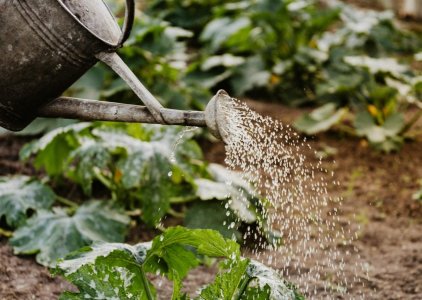Are you overwatering without realizing it? These 4 expert tips can help your plants thrive
By
Veronica E.
- Replies 0
If you’ve ever watched a houseplant go limp or a cheerful flower suddenly droop, you’re not alone.
Many of us assume we’re helping our plants by giving them a regular drink—but too much of a good thing can do more harm than good.
In fact, one of the most common mistakes new (and seasoned) plant owners make isn’t neglect—it’s improper watering.
When and how you water can make the difference between a thriving garden and a sad collection of wilted leaves.
The good news? A few simple tips can help you become the confident, green-thumbed caretaker your plants need.

1. Morning watering is best—but it’s okay if you miss it
Early morning is generally the ideal time to water.
It helps your plants start the day hydrated and gives any water on the leaves a chance to dry off before the sun gets too hot.
This lowers the risk of fungal diseases and prepares the plant for warmer temperatures ahead.
But if life gets in the way and you forget until midday, don’t panic.
The long-standing myth that watering under the hot sun will burn your plants has been largely debunked.
While a few sensitive varieties may get slight spotting, most plants won’t suffer any serious harm. If your plant looks thirsty—even in the middle of the day—go ahead and water it.
Also read: Do your supermarket plants always die? Here’s what experts want you to know
2. Try not to soak the leaves—but don’t stress if you do
Yes, it’s best to aim water directly at the base of your plant.
Roots are where the magic happens, and wet leaves can increase the risk of disease, especially for plants prone to mildew or leaf spot.
That said, don’t worry if some water ends up on the foliage.
After all, nature doesn’t hold back during a rainstorm.
The key is to avoid wetting the leaves every time, especially if the plant is in a humid or enclosed space with poor air circulation.
Also read: These signs will tell you if your plants are begging for more sunlight!
3. Water deeply—then let the soil dry out
This one’s important: watering too frequently can lead to shallow roots and unhealthy plants.
It’s better to give your plant a deep drink and then wait until the soil has dried before watering again.
This encourages roots to grow downward in search of moisture, making your plants stronger and more resilient.
A quick way to test? Stick your finger into the soil about an inch deep. If it feels dry, it’s time to water.
If it’s still damp, wait a day or two. And remember, wilted leaves don’t always mean your plant is thirsty—if the soil is wet and the plant continues to wilt, you may be dealing with root rot from overwatering.
Also read: Say goodbye to aphids! Discover 8 plants garden experts swear by for a pest-free summer
4. Learn the signs: dry wilting vs. wet wilting
Not all wilting is created equal.
When a thirsty plant perks up after watering, that’s a good sign.
But if it stays droopy or gets worse, there’s likely too much water in the soil and not enough oxygen reaching the roots.
To prevent this, make sure your pots have good drainage and never let containers sit in standing water.
If you garden in heavy clay soil, adding compost can improve drainage and reduce the risk of waterlogged roots.
Also read: Don’t let your garden dry out while you’re on vacation—here’s how to keep it thriving while you’re away
Bonus watering tips for older gardeners
Every plant is a little different—but with a better understanding of watering basics, you’ll be well on your way to a greener, healthier home or garden.
Happy watering!
Read next: Multiply your houseplants with ease—no green thumb required

Have you ever lost a plant to overwatering—or believed a gardening myth for years before learning the truth? Whether you’ve got a flourishing garden or a few struggling potted plants, we’d love to hear from you. Share your questions, your success stories, or even your funniest gardening missteps in the comments.
Many of us assume we’re helping our plants by giving them a regular drink—but too much of a good thing can do more harm than good.
In fact, one of the most common mistakes new (and seasoned) plant owners make isn’t neglect—it’s improper watering.
When and how you water can make the difference between a thriving garden and a sad collection of wilted leaves.
The good news? A few simple tips can help you become the confident, green-thumbed caretaker your plants need.

A peaceful morning watering routine can make all the difference for thriving, healthy plants. Image Source: Pexels / Photo By: Kaboompics.com.
1. Morning watering is best—but it’s okay if you miss it
Early morning is generally the ideal time to water.
It helps your plants start the day hydrated and gives any water on the leaves a chance to dry off before the sun gets too hot.
This lowers the risk of fungal diseases and prepares the plant for warmer temperatures ahead.
But if life gets in the way and you forget until midday, don’t panic.
The long-standing myth that watering under the hot sun will burn your plants has been largely debunked.
While a few sensitive varieties may get slight spotting, most plants won’t suffer any serious harm. If your plant looks thirsty—even in the middle of the day—go ahead and water it.
2. Try not to soak the leaves—but don’t stress if you do
Yes, it’s best to aim water directly at the base of your plant.
Roots are where the magic happens, and wet leaves can increase the risk of disease, especially for plants prone to mildew or leaf spot.
That said, don’t worry if some water ends up on the foliage.
After all, nature doesn’t hold back during a rainstorm.
The key is to avoid wetting the leaves every time, especially if the plant is in a humid or enclosed space with poor air circulation.
Also read: These signs will tell you if your plants are begging for more sunlight!
3. Water deeply—then let the soil dry out
This one’s important: watering too frequently can lead to shallow roots and unhealthy plants.
It’s better to give your plant a deep drink and then wait until the soil has dried before watering again.
This encourages roots to grow downward in search of moisture, making your plants stronger and more resilient.
A quick way to test? Stick your finger into the soil about an inch deep. If it feels dry, it’s time to water.
If it’s still damp, wait a day or two. And remember, wilted leaves don’t always mean your plant is thirsty—if the soil is wet and the plant continues to wilt, you may be dealing with root rot from overwatering.
Also read: Say goodbye to aphids! Discover 8 plants garden experts swear by for a pest-free summer
4. Learn the signs: dry wilting vs. wet wilting
Not all wilting is created equal.
When a thirsty plant perks up after watering, that’s a good sign.
But if it stays droopy or gets worse, there’s likely too much water in the soil and not enough oxygen reaching the roots.
To prevent this, make sure your pots have good drainage and never let containers sit in standing water.
If you garden in heavy clay soil, adding compost can improve drainage and reduce the risk of waterlogged roots.
Also read: Don’t let your garden dry out while you’re on vacation—here’s how to keep it thriving while you’re away
Bonus watering tips for older gardeners
- Use lightweight watering tools to protect your hands, wrists, and shoulders.
- Group plants by water needs to simplify your routine.
- Try self-watering pots or drip irrigation if you prefer low-maintenance solutions.
- Keep a small garden journal to track what’s working and when you last watered—especially helpful during hot months.
Every plant is a little different—but with a better understanding of watering basics, you’ll be well on your way to a greener, healthier home or garden.
Happy watering!
Read next: Multiply your houseplants with ease—no green thumb required
Key Takeaways
- Watering your plants in the morning is best, as it prepares them for the day’s heat and reduces the risk of fungal issues caused by wet foliage.
- Contrary to common belief, watering in the middle of the day won’t burn your plants, though some may develop harmless cosmetic spots.
- Aim to water the soil directly rather than the leaves, and only water again once the soil has had time to dry out to prevent root rot.
- Understanding the difference between underwatering and overwatering can help you respond to wilting correctly and keep your plants healthy.
Have you ever lost a plant to overwatering—or believed a gardening myth for years before learning the truth? Whether you’ve got a flourishing garden or a few struggling potted plants, we’d love to hear from you. Share your questions, your success stories, or even your funniest gardening missteps in the comments.






